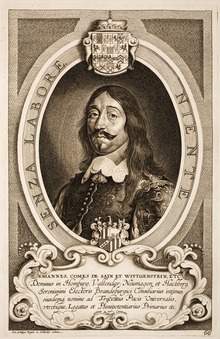Johann VIII. (Sayn-Wittgenstein-Hohenstein)
Johann VIII zu Sayn-Wittgenstein-Wittgenstein (* October 14, 1601 ; † April 2, 1657 ), from 1651 Count zu Sayn-Wittgenstein -Hohenstein, was a German military, diplomat and Brandenburg governor.
Johann fought for several years in the Thirty Years War as a Swedish colonel .
From 1633 to 1634 he was a member of the Consilium formatum . In 1642 he was appointed privy councilor of Brandenburg and from 1645 onwards he was instrumental in the peace negotiations in Münster and Osnabrück , which led to the Peace of Westphalia in October 1648 . He negotiated with Sweden the exchange of Western Pomerania for the Principality of Minden and the abandoned dioceses of Cammin , Halberstadt and the eligibility for the diocese of Magdeburg . In the end, a payment of 45,000 Reichstalers to the Swedish ambassadors was decisive.
The Great Elector, Friedrich Wilhelm von Brandenburg , signed Count Johann over to the County of Hohenstein in 1647 for his services in the peace negotiations. In 1649 he was appointed governor in the newly won Principality of Minden and in the County of Ravensberg . Together with his mint master Behrend Levi , from 1655 to 1657 he triggered regional inflation through deterioration in coins , which led to resistance from those affected.
family
Johann was born as the second son of Count Ludwig II zu Sayn-Wittgenstein-Wittgenstein , who later became regent of the southern county of Wittgenstein. Since his older brother died early, he inherited the county. Johann married Anna Auguste on June 30, 1627 (* March 31, 1608; † May 27, 1658), the daughter of Count Christian von Waldeck-Wildungen and his wife, Countess Elisabeth zu Nassau-Siegen. The couple had the following children:
- Ludwig Christian (January 17, 1629 - January 25, 1683)
- ∞ 1656 Elisabeth Margarete zu Solms-Greiffenstein (* 23 May 1637; † 1681);
- ∞ 1682 Anna Elisabeth Vijgh
- Georg Wilhelm (February 6, 1630; † 1657), drowned.
- Johann Friedrich (born April 19, 1631; † April 28, 1656), died in a duel in Königsberg.
- Gustav Otto (April 14, 1633; † October 15, 1701) ∞ 1657 Anne Helene de La Place (* 1634; † February 24, 1705) (parents of August David zu Sayn-Wittgenstein-Hohenstein )
- Heinrich Ernst (* 1637; † 1637)
- Otto (* July 14, 1639; † 1683), killed in the war against the Turks. He left three illegitimate children who were named by Schwartzenstein .
- Friedrich Wilhelm (born November 20, 1647; † November 10, 1685) ∞ 1671 Charlotte Luise zu Leiningen-Dagsburg-Hartenburg (born October 2, 1652; † June 6, 1713)
- Elisabeth Juliane (* October 4, 1634; † March 23, 1689) ∞ 1654 Count Jodokus Hermann II zur Lippe-Biesterfeld (* February 9, 1625; † July 6, 1678)
- Anna Sophie (born November 2, 1635)
- Auguste Johanna (April 12, 1638 - May 15, 1669) ∞ 1659 Anton I von Aldenburg , Count of Knyphausen (February 1, 1633 - October 27, 1680)
- Christine Luise (born August 23, 1640)
- Christina (* 1645)
- Anna Maria Magdalene (October 15, 1641; † February 16, 1701) ∞ 1670 Count Wilhelm Friedrich zu Sayn-Wittgenstein-Homburg (* July 16, 1640; † October 28, 1698)
- Luise Philippine (January 8, 1652 - March 5, 1722)
- Concordia (October 28, 1648 - January 25, 1683)
- ∞ September 30, 1669 Count Ludwig Günther von Schwarzburg-Ebeleben (* March 2, 1621; † July 20, 1681)
- ∞ June 20, 1681 Count Karl Ludwig zu Sayn-Wittgenstein-Neumagen (* June 20, 1658; † September 16, 1724)
literature
- Otto Meinardus: Wittgenstein, Johann VIII., Count zu Sayn- . In: Allgemeine Deutsche Biographie (ADB). Volume 43, Duncker & Humblot, Leipzig 1898, pp. 619-623.
- Günther Wrede : Territorial history of the county of Wittgenstein. NG Elwertsche Verlagbuchhandlung, Marburg 1927.
- Gunnar Teske: citizens, peasants, mercenaries and envoys. The Thirty Years War and the Peace of Westphalia in Westphalia . Arday-Verlag, Münster, 1997
- Ulf Lückel and A. Kroh: The Princely House of Sayn-Wittgenstein-Hohenstein . 2nd edition, Werl 2004 (= German Princely Houses, Volume 11).
- Karl Großmann : Count Johann VIII of Sayn-Wittgenstein-Hohenstein. A picture of life from the time of the 30 Years War and a contribution to the history of the County of Wittgenstein. Laasphe, 1922.
- Andreas Krüger: The "Wittgenstein" bulwark in Berlin . In: Wittgenstein. Leaves of the Wittgensteiner Heimatverein, issue 2, 2012, pp. 44–48
Web links
Individual evidence
- ↑ Gunnar Teske: Citizens, Peasants, Mercenaries and Envoys. The Thirty Years War and the Peace of Westphalia in Westphalia . Arday-Verlag, Münster, 1997, pp. 158-170.
- ^ Gunnar Teske: Citizens, Peasants and Envoys . 1998, p. 173 .
- ↑ Martin Krieg: Die Juden in der Stadt Minden until 1723 , WZ 1937, p. 134. Internet portal “Westfälische Geschichte”, URL: http://www.westfaelische-zeitschrift.lwl.org online, pdf
- ↑ Family table of the mediatized house Sayn and Wittgenstein 1907. Plate 10. Unchanged reprint of the 1907 edition, Heimatverlag and Antiquarian Bookshop Angelika Wied. Bad Laasphe 2009, No. 9/100
- ^ Genealogical description of all graffen und Herren des HR Reichs now living , Regensburg 1722, p. 68.
- ^ Sayn-Wittgenstein and Hohenstein in Vallendar, Friedrich Wilhelm Graf zu. Hessian biography. In: Landesgeschichtliches Informationssystem Hessen (LAGIS).
| personal data | |
|---|---|
| SURNAME | John VIII |
| ALTERNATIVE NAMES | Johann VIII zu Sayn-Wittgenstein-Hohenstein |
| BRIEF DESCRIPTION | Brandenburg envoy to the Peace of Westphalia |
| DATE OF BIRTH | October 14, 1601 |
| DATE OF DEATH | April 2, 1657 |

